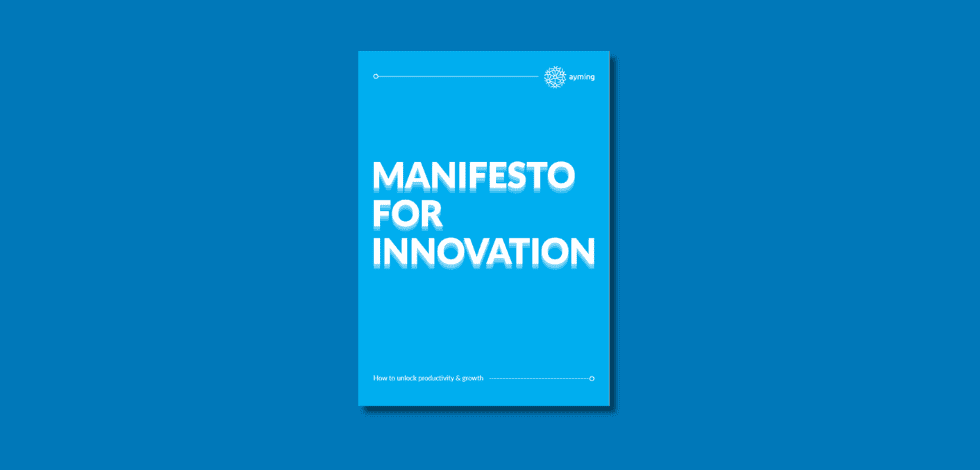The following is an extract from Ayming’s International Innovation Barometer 2022. You can download the full report here.
Our first Innovation Barometer in 2019 cautioned that demand for Research & Development (R&D) was about to surge. We could never have known how right those findings were.
Since the pandemic struck, businesses have faced previously unimaginable adversity. The drastic and rapid changes in social and economic behaviours have forced an adjustment to business models, both in terms of how they operate and sell.
But it is in this very environment that innovation flourishes. Such fundamental shifts bring both opportunity and risk for all firms. Competition has ramped up and markets are ripe for disruption. No doubt, future sector leaders have been founded during the pandemic. We can already see start-ups emerging with new, future-facing propositions.
The problem is the pandemic has created a conflicting paradigm wherein innovation is more essential, but also more difficult. Those who successfully pivot to new opportunities will flourish, while those who don’t will be left behind. It’s no exaggeration to say that what businesses are doing now is shaping the future.
As we move into the post-Covid economy, innovation will be vital. Not only are economies in desperate need of a boost, but several big challenges lie ahead, such as climate change. But if there’s one thing innovators do best, it’s solve problems. We have to empower businesses and individuals to innovate because, ultimately, we rely on them for the solutions.
Fortunately, the pandemic has taught some valuable lessons. It has re-enforced the value of R&D and businesses can take inspiration from the many successes, such as the vaccine, and apply it to enhancing the innovation process. The emergence of new technologies and new platforms that facilitate open innovation are cause for enthusiasm.
All of this, though, depends on funding. Businesses must have access to the funding to ramp up R&D activity, for which there is a role for us in helping to ensure they have all the funding possible and are making full use of the significant state funding that is now becoming available.
Turbulent change
After one of the most turbulent and transformative years in living memory, in which radically innovative goods, services and inventions played a critical role, attitudes to innovation more generally have inevitably changed. There is a growing pressure on organisations to do more, faster. Short-term growth has become a much more important driver. And public resources and funding are playing a more important role.
Complexity and confidence
Looking at the numbers in more depth, the number of respondents who feel their organisation undertakes enough innovation has fallen 14 points, from 85 per cent last year, to 71 per cent this year. Conversely, the share of respondents who feel that not enough innovation is being done has almost doubled: from 12 per cent to 23 per cent.
The number of respondents who believe that innovation is being driven by the increased capabilities of their own R&D team has also fallen, from 36 per cent to 20 per cent. Faith in internal R&D is particularly low among the Chemical, Construction & Civil Engineering sectors.
Part of this seeming loss of confidence can be attributed to timing. In 2020, the data was gathered at a time when many believed that Covid-19 would be a short, albeit dramatic, event. Now, as a more established feature of daily life, it has triggered a growing sense that current prosperity is rather fragile.
“We’ve been speaking about a VUCA world for about 30 years,” says Fabien Mathieu, Partner and Managing Director at Ayming France. “Volatile, uncertain, complex, and ambiguous: really since the end of the Cold War, when some of our more simplistic assumptions and easy alliances swiftly eroded. Today it’s the climate crisis. Given that the past year has put health risks – to us as individuals and as societies – under the spotlight, we perhaps shouldn’t be too surprised that confidence in innovation strategies has dropped.”
Innovation hotspots
As ever, there are sectoral differences and intra-country contrasts. The sector with the least confidence in its innovative capacities is now health and pharmaceuticals, despite dramatic breakthroughs in vaccine development. Lack of confidence is also most often expressed in Belgium, Spain and Ireland.
The most confident nation remains the US (alongside the Netherlands). There are inevitably long-term cultural reasons: the US has always considered itself the land of opportunity, which perpetuates the belief in itself as the home of innovation.
It also helps that the US is still riding high on a period of economic momentum that began during the previous administration and appears to have been given a boost by the new incumbent’s willingness to provide more incentives for ambitious infrastructure projects.
The long and the short of it
As to drivers of innovation, long-term trends and future market demand remains top of the list: in fact it has jumped from 38 per cent last year to 57 per cent this time – rising further still, to 72 per cent, among consumer goods companies. The number citing keeping pace with competitors as a driver also increased from 37 per cent to 46 per cent. Rounding out the top three, short-term growth opportunities are a driver for 34 per cent of respondents – an increase of 13 points and a leap from last place to third.
Innovation strategies have always expressed a duality between the short term and long-term prospects.
Business leaders will therefore need to manage and direct innovation over several timeframes, which will almost certainly increase demand for more predictability in product and service development and is likely to re-define what is expected of minimum viable products (MVPs).
Insiders and outsiders
When it comes to the resources firms rely on for innovation, the overall picture is one of growing dependence on internal R&D resources, as firms stuck with the trusted and familiar over the past twelve months. “Internally, you have people who are used to running customer projects to a certain rhythm,” says Olivier Taque, Innovation Project Manager at engineering services company Bertrandt, who is based in France.. “So while we always want to work with engineering schools and the like, there is a certain reliability and agility that comes with internal resources – something that will have been very important in the past year.”
External private resources, such as R&D from other companies, service providers, or subcontractors, remain the least relied on – but the spread between most and least preferred options has again increased. The share of companies turning to internal resources has grown from 58 per cent to 67 per cent, while the share using external private resources has decreased dramatically from 47 per cent to just 29 per cent. This is a major reversal from the position reported in 2020, when there was a major jump in the use of external private resources.
However, the number of firms looking to external public resources, such as universities and public research laboratories for their innovation work has also seen a drop over the past year, albeit less severe – from 42 per cent to 35 per cent. What’s more, the share of organisations who say that their ability to access new public funding opportunities is a key driver of innovation has fallen from 25 per cent to 18 per cent. These changes can in part be laid at the door of recent changes to national schemes for R&D tax credits, which have altered the incentives for commercial cooperation of this nature.
The area that has remained most steady – for now – is collaboration or joint ventures with other organisations, which was the preference for 43 per cent (last year) and 44 per cent (this year). Collaborations are more frequent in the US and Canada and run at their highest among Energy and Biotech firms but are lowest among consumer goods and manufacturing firms who are both more reliant on external private resources. This sector contrast is likely driven by the different competitive natures of these sectors.
Nonetheless, the amount of collaboration is likely to increase from this point. A more collective intelligence will be necessary to tackle the big projects of tomorrow: the challenge will be to harness the possibilities opened up by remote working, while overcoming the difficulties it presents in initiating and cementing effective partnerships. Nonetheless, we can expect a more open approach to building innovative ecosystems, driven by necessity if not self-interest.
Local vs Global innovation
There has been a subtle retraction from internationalism in the past year. Local-only innovation has increased from 42 per cent to 47 per cent, while international-only has dropped from 11 per cent to a mere two per cent. For those who do opt to innovate internationally, the US is the top choice, followed by Germany and the UK.
Given the pandemic mitigation measures that have made travel more difficult and logistics even more challenging, it is perhaps not surprising that firms have looked closer to home for their innovation sites. But there is also a more atavistic reason behind it: the urge to ‘buy local’ is still strong, and a local anchor is a key strength for many marketing campaigns.
For Taque, the reasons for local innovation are largely to do with language, culture, and customer expectations.
‘‘Is the market ready at the right time for your preferred innovation? Are customer demands the same in different locations? They go at different speeds, so there is rarely a universal requirement or demand.”
However, the number of firms who combine local with international innovation has increased slightly from 47 to 51 per cent and remained the most popular option. The mixed model is most prominent in the US and Canada, where businesses are also more likely to look to collaborations to resource their innovation.
Follow the talent
We also asked respondents which factors influence their choice of innovation location. Once again, availability of talent tops the list, and is most likely to influence companies in France and Ireland, as well as companies in the Healthcare & Pharmaceutical sectors.
“The way we view talent has shifted over the past year, says Mathieu. “There’s growing concern surrounding the current cohort of graduates, who have missed out on important aspects of their university education. The pipeline is perhaps not as gold-plated as once it was.”
“Access to talent is obviously a key driver of innovation,” says Tina Carling, Innovation Director at Morgan Sindall Infrastructure & Innovation.
However, this year the availability of tax credits (16 per cent) has moved up the rankings and is now ahead of grants (13 per cent) as the funding mechanism most likely to influence the location of innovation effort. “Grant schemes have not necessarily proved their value over the past few years, with success rates lower than expected,” says Mathieu. “Tax credits present less risk to the public purse. With Covid recovery packages coming into play, I expect a more complementary balance between grants and credits to be the norm.”
“But the world is changing, and people could well be reassessing their priorities, so companies need to think about how they continue to attract them, and that could well be a question of location.”
Key innovation observations
Given the upheaval faced over the past year, it is perhaps not surprising that many businesses have struggled to innovate as much as they might like.
This is reflected in the general shape of R&D activity, which has become a more insular affair. Companies are more likely than in the past to depend on their own internal resources to innovate and slightly less likely to look to international innovation efforts to drive progression.
As the world begins to open back up over the coming year, we hope to see a reversal of these trends – and a resurgence in confidence in R&D teams’ abilities to be real drivers of innovation.
Talent will be central to this and companies will be keeping a close eye on the health of the next generation of innovators as they plan their future R&D.
To read the full report, you can download Ayming’s International Innovation Barometer here.













No Comments